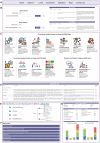AgeAnno: a knowledgebase of single-cell annotation of aging in human
- PMID: 36200838
- PMCID: PMC9825500
- DOI: 10.1093/nar/gkac847
AgeAnno: a knowledgebase of single-cell annotation of aging in human
Abstract
Aging is a complex process that accompanied by molecular and cellular alterations. The identification of tissue-/cell type-specific biomarkers of aging and elucidation of the detailed biological mechanisms of aging-related genes at the single-cell level can help to understand the heterogeneous aging process and design targeted anti-aging therapeutics. Here, we built AgeAnno (https://relab.xidian.edu.cn/AgeAnno/#/), a knowledgebase of single cell annotation of aging in human, aiming to provide comprehensive characterizations for aging-related genes across diverse tissue-cell types in human by using single-cell RNA and ATAC sequencing data (scRNA and scATAC). The current version of AgeAnno houses 1 678 610 cells from 28 healthy tissue samples with ages ranging from 0 to 110 years. We collected 5580 aging-related genes from previous resources and performed dynamic functional annotations of the cellular context. For the scRNA data, we performed analyses include differential gene expression, gene variation coefficient, cell communication network, transcription factor (TF) regulatory network, and immune cell proportionc. AgeAnno also provides differential chromatin accessibility analysis, motif/TF enrichment and footprint analysis, and co-accessibility peak analysis for scATAC data. AgeAnno will be a unique resource to systematically characterize aging-related genes across diverse tissue-cell types in human, and it could facilitate antiaging and aging-related disease research.
© The Author(s) 2022. Published by Oxford University Press on behalf of Nucleic Acids Research.
Figures



References
-
- Strihler B. Times, Cells, and Aging. 2012; Elsevier.
-
- Niccoli T., Partridge L.. Ageing as a risk factor for disease. Curr. Biol. 2012; 22:R741–R752. - PubMed
Publication types
MeSH terms
Substances
Grants and funding
LinkOut - more resources
Full Text Sources
Medical
Miscellaneous

